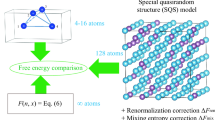Abstract
That viscosity and fluidity are equilibrium processes may be established on the basis of the Boltzmann distribution in terms of randomized particles. Specifically, the virtual presence of three classes of particles— with crystal mobility, liquid mobility, and vapor mobility—is assumed. Accordingly, the viscosity and fluidity of solutions—in particular, molten metallic alloys—may be considered in terms of the equilibrium contributions of each component to the total viscosity and fluidity, despite the kinetic interpretation of the usual expressions for these liquid properties. A linear additive equation for the viscosity is only possible for perfect solutions; for present purposes, that corresponds to alloys with unlimited mutual solubility of the components. Alloys with eutectics, chemical compounds, and other singularities in the phase diagram are characterized by viscosity equations that reproduce the shape of the liquidus curve over the whole range of alloy composition at different temperatures. Greater smoothness and closeness of the curves is observed at higher temperatures. These aspects of the temperature dependence of the viscosity may be explained on the basis of randomized particles and the visual cluster model of viscosity, with calculation of the proportions of the clusters that determine the alloy viscosity. Such viscosity is determined from a formula in which the thermal barrier to randomization is the thermal energy RTcr at the liquidus temperature, which is characterized by the temperature of melt crystallization Tcr, analogously to the melting point of the pure materials. On that basis, we propose a method of calculating the alloy viscosity from the phase diagram. From the temperature dependences of the viscosity of the pure components, the alloy viscosity may be determined from the proportion of clusters at any temperature above the liquidus curve and the viscosities of the pure components, taking account of the mole fraction of each component. The result is a trifactorial model of the viscosity of a liquid alloy. In this model, the variable is the thermal barrier RTcr to randomization, which determines the proportion of clusters both for pure materials (at RTcr = RTm) and for alloys. Overall, this model corresponds to the virtual cluster theory of viscosity and is consistent with the concept of randomized particles.
Similar content being viewed by others
References
Elanskii, G.N. and Kudrin V.A., Stroenie i svoistva zhidkogo metalla–tekhnologiya plavki–kachestvo stali (Structure and Properties of Liquid Metal–Melting Technology–Quality of Steel), Moscow: Metallurgiya, 1984.
Elanskii, G.N. and Elanskii, D.G., Stroenie i svoistva metallicheskikh rasplavov (Structure and Properties of Metallic Melts), Moscow: Mosk. Gos. Vechern. Metall. Inst., 2006.
Baum, B.A., Metallicheskie zhidkosti (Metallic Liquids), Moscow: Nauka, 1979.
Baum, B.A., Tyagunov, G.V., Baryshev, E.E., and Tsepelev, E.S., Fundamental’nye issledovaniya fiziko-khimii metallicheskikh rasplavov (Fundamental Research of Physical Chemistry of Metallic Melts), Moscow: Akademkniga, 2002.
Gavrilin, I.V., Plavlenie i kristallizatsiya metallov i splavov (Melting and Crystallization of Metals and Alloys), Vladimir: Vladimir. Gos. Univ., 2000.
Zborshchik, A.M., Teoreticheskie osnovy metallurgicheskogo proizvodstva (Theoretical Foundations of Metallurgical Production), Donetsk: Donetsk. Nats. Tekh. Univ., 2008.
Fundamental’nye issledovaniya fizikokhimii metallicheskikh rasplavov (Fundamental Studies of the Physical Chemistry of Metal Melts), Lyakishev, N.P., Ed., Moscow: Akademkniga, 2002.
Vol, A.E. and Kagan, I.K., Stroenie i svoistva dvoinykh metallicheskikh sistem (Structure and Properties of Binary Metal Systems), Moscow: Nauka, 1979, vol. 4.
Cherepakhin, A.A., Koltunov, I.I., and Kuznetsov, V.A., Materialovedenie: uchebnik (Materials Science: Manual), Moscow, 2009.
Churkin, B.S. and Kotegorenko, Yu.I., Teoriya liteinykh protsessov. Uchebnoe posobie (Theory of Foundry Processes: Manual), Yekaterinburg, 2006.
Schlackenatlas, Düsseldorf: Verlag Stahleisen, 1981.
Baisanov, S.O., Gabdullin, T.G., and Takenov, T.D., Construction of composition-property diagrams of aluminosilicate melts by the simplex lattice method, Izv. Vyssh. Uchebn. Zaved., Chern. Metall., 1982, no. 2, pp. 145–146.
Tolokonnikova, V.V., Baisanov, S.O., and Kulikov, I.S., Generalized equations for liquidus and solidus curves in binary iron-based systems, Izv. Akad. Nauk SSSR, Met., 1989, no. 2, pp. 34–33.
Meshalkin, A.B., Investigation of phase equilibria and estimation of thermodynamic properties of melts in binary inverse systems, Teplofiz. Aerodin., 2005, vol. 12, no. 4, pp. 669–684.
Denisov, V.M., Belousova, N.V. Istomin, S.A., Bakhvalov, S.G., and Pastukhov, E.A., Stroenie i svoistva rasplavlennykh oksidov (Structure and Properties of Molten Oxides), Yekaterinburg: Ural. Otd., Ross. Akad. Nauk, 1999.
Glazov, V.M. and Pavlova, L.M., Khimicheskaya termodinamika i fazovye ravnovesiya (Chemical Thermodynamics and Phase Equilibria), Moscow: Metallurgiya, 1988.
Malyshev, V.P., Bekturganov, N.S., and Turdukozhaeva, A.M., Vyazkost’, tekuchest’ i plotnost’ veshchestv kak mera ikh khaotizatsii (Viscosity, Fluidity, and Density of Substances as a Measure of Their Chaotization), Moscow: Nauchnyi Mir, 2012.
Malyshev, V.P., Tolymbekov, M.Zh., Turdukozhaeva, A.M., Kazhikenova, A.Sh., and Akuov, A.M., Application of the generalized semiempirical model of melts viscosity based on the concept of randomized particles for slag systems, Rasplavy, 2010, no. 1, pp. 76–84.
Malyshev, V.P., Tolymbekov, M.Zh., Turdukozhaeva, A.M., Kazhikenova, A.Sh., and Akuov, A.M., Flow of melts as the destruction of cluster associates, Rasplavy, 2010, no. 6, pp. 43–49.
Malyshev, V.P. and Turdukozhaeva, A.M., Refinement of the cluster-associative model of melts viscosity based on the temperature effect on the degree of clusters association, Rasplavy, 2011, no. 6, pp. 72–79.
Soroko, E.M., Strukturnaya garmoniya sistem (Structural Harmony of Systems), Minsk: Nauka i Tekhnika, 1985.
Wigner, E.P., Symmetries and Reflections: Scientific Essays, Westport, CT: Greenwood, 1967.
Fedorov, P.P., Material science and phase diagrams, Materialy Vserossiiskoi konferentsii s mezhdunarodnym uchastiem i 12-go Vserossiiskogo simpoziuma s mezhdunarodnym uchastiem “Khimiya tverdogo tela i funktsional’nye materialy–2018. Termodinamika i Materialovedenie,” Sankt-Peterburg, Tezisy dokladov (Proc. All-Russ. Conf. with Int. Participation and 12 All-Russ. Symp. with Int. Participation “Solid State Chemistry and Functional Materials–2018. Thermodynamics and Material Science,” St. Petersburg, Abstracts of Papers), St. Petersburg, 2018.
Author information
Authors and Affiliations
Corresponding author
Additional information
Original Russian Text © V.P. Malyshev, A.M. Makasheva, 2018, published in Izvestiya Vysshikh Uchebnykh Zavedenii, Chernaya Metallurgiya, 2018, No. 9, pp. 743–749.
About this article
Cite this article
Malyshev, V.P., Makasheva, A.M. Determination of the Dynamic Viscosity of Liquid Alloys from the Phase Diagram. Steel Transl. 48, 578–584 (2018). https://doi.org/10.3103/S0967091218090073
Received:
Published:
Issue Date:
DOI: https://doi.org/10.3103/S0967091218090073




